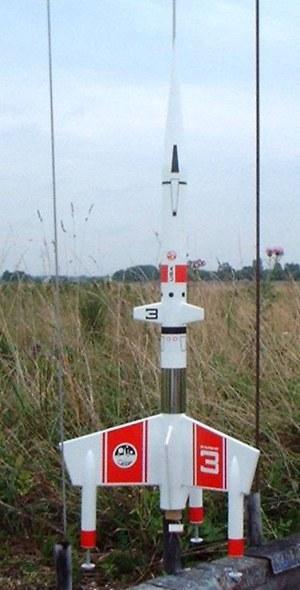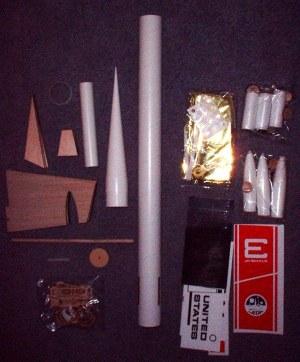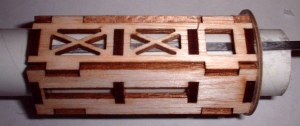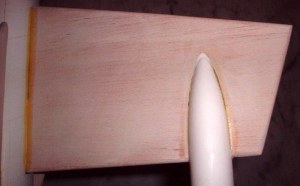| Construction Rating: | starstarstarstarstar_border |
| Flight Rating: | starstarstarstarstar |
| Overall Rating: | starstarstarstarstar_border |
| Manufacturer: | Qmodeling  |
Brief:
This kit is a beautiful upscale and upgrade to the Estes classic Starship Vega.
Magnificently engineered and loaded with top-quality components and features,
this rocket would be a great addition to any BAR's fleet. From what I can tell,
upgrades to the original design include nose cones on the wing pods/landing
gear, a fully functional set of shock absorbers in the landing gear, and a very
impressive motor mount/thru-wall fin mounting. It's also up-scaled to a BT-60
tube and 24mm motor.
Construction:
As I opened this kit, I immediately noticed the hand-checked parts list on the
outside of the bag header card. Nice touch, and not surprisingly the parts were
complete and in good shape. The decal pack was missing one decal, which the
staff at QModeling caught before I noticed it, and a replacement was already in
the mail before I contacted them. Now THAT's customer service.
The parts list for this kit is fairly extensive due to the fully functional landing gear assembly. Parts were top-notch quality, with fins and rings all laser-cut. The body tubes are white paper/cardboard with very light spirals. Mine had a slight dimple from tight packaging, but was easily repaired. The motor mount tube is foil-lined, something I've rarely seen in commercial kits for the modroc crowd.
One nice touch to the parts assortment is that they were bagged in modular fashion, so rather than sort through dozens of small parts in the early stages of construction, you simply find the bag for the sub-assembly you're working on, and pull out the bag which contains all the parts for that assembly.

Throughout the construction of this kit, I kept getting the feeling that this is what happens when guys with access to high-tech manufacturing equipment and an interest in rocketry get too much idle time. Everything about this kit is precisely engineered and fits perfectly. This kit is loaded with great design features to make it fly well and last forever. I'd rate it somewhere between a 2 and 3 on the difficulty scale, leaning towards a 3 based on the intricacy of the landing gear and motor mount as well as the through-wall fins.
The 18-page instruction manual is very well written and illustrated, and filled with plenty of construction tips and 'whys'. Construction begins with the motor mount assembly, which is a 24mm tube framed by balsa. The design is similar to the Estes E2X-series plastic frames, but with the supports cut into the balsa, I suspect this is both lighter and stronger. The 6 balsa braces fit snugly around 4 centering rings. Parts were perfectly dimensioned, and I had very little sanding for the fit. The intricate laser work on the balsa was just amazing!
 |
The landing gear assembly consists of three BT-20 tubes with mini piston assemblies and springs, acting as shock absorbers. This is a terrific upgrade to the Estes design. This is a heavy-duty kit, and not likely to suffer damage under a normal descent, but the shocks are a cool touch. As evidence of the level to which this kit has been engineered, the 'feet' of the landing gear are two small wooden disks, one smaller than the other, with the larger one having a laser-engraved centering line to properly locate the smaller one. The landing gear is topped off with resin-cast nose cones, offering a much better appearance than the original Estes open-tube design.
 The fins are pre-cut for mounting the pod/landing gear, and I
was very surprised by how well these fit. On my kit, I had to sand the rougher
edges a bit, and had a small amount of area at the point of the cone to fill
with paste, but the finished product looks as though the cones and tube were
cast directly with the fin. I did find aligning the tubes to be a bit of a
challenge, and would have loved to see a template or alignment pattern, but
eyeballing can still work fairly well.
The fins are pre-cut for mounting the pod/landing gear, and I
was very surprised by how well these fit. On my kit, I had to sand the rougher
edges a bit, and had a small amount of area at the point of the cone to fill
with paste, but the finished product looks as though the cones and tube were
cast directly with the fin. I did find aligning the tubes to be a bit of a
challenge, and would have loved to see a template or alignment pattern, but
eyeballing can still work fairly well.
Before bonding the fins, I like to fill spirals on the body tube, and that helps on this kit, as there are a total of (6) fins at the aft end of the rocket, making sanding in that area a bit tricky. After filling and sanding the spirals, I mounted the motor mount and bonded the through-the-wall fins. The fin tabs were a bit too long (the first part of this that actually needed any work for a perfect fit), but once trimmed they fit very well in the slots in the balsa framework inside.
The nose cone 'assembly' is completed by inserting a plug and crew eye into a resin-cast cone. There was only a slight trace of a parting line on the cone, requiring a scrape or two with a razor blade to remove the flashing.
If there is a weak spot to this kit, I'd have to say it's in the recovery system. The kit comes with a very nice 24" mylar parachute (mine was gold), but only 6 shroud lines of 18" length. Optimal shroud lines for this size chute would be (8) 24-36" lines. The shock cord was 24 inches of ¼" elastic using an Estes-style paper tri-fold mount. Given that this rocket is over 30" tall, I substituted 48 inches of ¼" elastic tied to 120-pound Kevlar® line and used an epoxy clay mount.
Finishing:
Finishing this rocket requires a little bit of care and effort due to the
amount of decals supplied. The foundation is a basic all-white finish applied
over a couple coats of primer. The decals were mostly water-slide, and seemed
to be much more durable than the common decals I've seen almost everywhere
else. These need to soak a little longer, but when they went on they really
stuck. The kit also comes with a metallic silver decal with black lines printed
on it, though on mine the black stripes flaked off almost immediately, so I had
to touch up with a black marker. I topped everything off with a Krylon gloss
coat.
Construction Rating: 4 ½ out of 5
Flight:
The only reference to motor selection for this was a comment to follow NAR
code, and select a D or E engine. With such large fins and weighing a little
over 10 ounces, I decided to use an E9-6 for the first flight. The rocket went
up on a very slow, perfectly straight path, and watching the flame of the
slow-burning E9 was impressive. The 6-second delay proved to be too late, as
deployment was past apogee, resulting in a tangled chute (maybe I should have
stuck with their shorter shock cord!). Even with the tangled chute and a fairly
rough landing, the rocket was undamaged and ready for another flight. For its
next launch, I think I'm going to have to upgrade to an F, as this is rugged
enough to handle the higher thrust curves.
Flight Rating: 5 out of 5
Summary:
QModeling's mission is to bring back the classics (there's a poll on at
www.qmodeling.com for which one to do
next), and based on this I'd have to say they're off to a great start. This is
a great-looking rocket that will handle lots of flights, and while sticking
close to the original Estes design, they've truly enhanced it with superior
engineering and quality components.
Overall Rating: 4 ½ out of 5
Other Reviews
- Qmodeling VEGA By Stu Young (November 21, 2009)
Brief: Upscale of an Estes vintage exotic kit. Construction: 2 17" cardboard body tubes, 3 cardboard tubes for landing leg pods, steel springs for the shock-absorbing landing legs, high-quality, laser-cut balsa fins and motor mount "exoskeleton," reflective, heat-resistant coating inside 24 mm motor mount, steel engine retaining hook (long enough for a BP ...
- Qmodeling VEGA By Jeff Drongowski
QModeling of Temecula, CA has put together a great looking upscale remake of the old Estes Vega rocket. The kit has always been one of the more interesting looking "retro" rockets put in to flight and QModeling has done a fine job with this kit. She is a single stage, single motor, parachute recovered (with real spring loaded landing pods as part of the fins) model made of paper tubes, ...
- Qmodeling VEGA By Darren Longhorn
( Contributed - by Darren J Longhorn) Brief: The MRS-Vega is part of Q Modeling's Mega Retro Series. The series comprises upscale semi-clones of some classic designs, that also includes the Mars Snooper, NikeX & WACC. I say semi-clones, because the kits have been rescaled and designed from scratch using new parts and the latest techniques. The Vega is described as an upscale of ...
 |
 |
Flights
 |
 |
T.D. (September 11, 2003)
T.P.Q. (February 5, 2004)
 |
 |
R.L. (September 11, 2003)